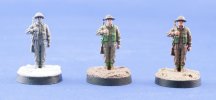Hi all,
I am relatively new to scale modelling, it’s a hobby I enjoy very much. I am stuck when it comes to washes, especially on infantry and tank crews. Anytime I do a wash, the wash also darkens and stains the uniforms. I just can’t seem to get it to stay only in outline details without staining the uniform along with it. I was hoping someone on here would have some tips for me? Any help would be appreciated.
Thanks
Alan
I am relatively new to scale modelling, it’s a hobby I enjoy very much. I am stuck when it comes to washes, especially on infantry and tank crews. Anytime I do a wash, the wash also darkens and stains the uniforms. I just can’t seem to get it to stay only in outline details without staining the uniform along with it. I was hoping someone on here would have some tips for me? Any help would be appreciated.
Thanks
Alan

